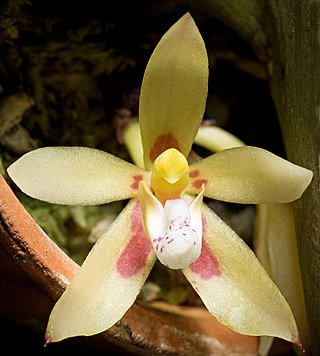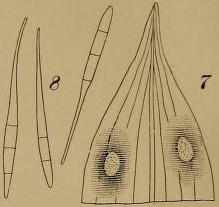
Phallus indusiatus, commonly called the basket stinkhorn, bamboo mushrooms, bamboo pith, long net stinkhorn, crinoline stinkhorn, bridal veil, or veiled lady, is a fungus in the family Phallaceae, or stinkhorns. It has a cosmopolitan distribution in tropical areas, and is found in southern Asia, Africa, the Americas, and Australia, where it grows in woodlands and gardens in rich soil and well-rotted woody material. The fruit body of the fungus is characterised by a conical to bell-shaped cap on a stalk and a delicate lacy "skirt", or indusium, that hangs from beneath the cap and reaches nearly to the ground. First described scientifically in 1798 by French botanist Étienne Pierre Ventenat, the species has often been referred to a separate genus Dictyophora along with other Phallus species featuring an indusium. P. indusiatus can be distinguished from other similar species by differences in distribution, size, color, and indusium length.

Verticillium albo-atrum is a plant pathogen with many hosts.
Calonectria colhounii is a fungal plant pathogen.
Calonectria ilicicola is a fungal plant pathogen in the family Nectriaceae. It has been found to cause leaf spot in holly, root rot in blueberry, red crown rot in soybean, a root and crown rot of anthurium, and a soft rot of ginger.

Calonectria kyotensis is a fungal plant pathogen. It is known to affect harvested durians, including from Durio graveolens and D. kutejensis.
Calonectria pyrochroa is a fungal plant pathogen infecting tea.
Calonectria quinqueseptata is a fungal plant pathogen.
Hebeloma atrobrunneum is a species of mushroom in the family Hymenogastraceae. Described as new to science in 1989, it was found on moist soil growing under Willow plants in Denmark.

Brachypeza, commonly known as sage orchids, is a genus of flowering plants from the orchid family, Orchidaceae. Orchids in this genus have short stems with fleshy leaves and arching flowering stems with short-lived flowers. The sepals and petals are similar in size and shape and the labellum is pouch-like and suspended at the base of the flower. Sage orchids occur in tropical areas from Indochina to New Guinea.

Calonectria is a genus of ascomycete fungi. Calonectria species are plant pathogens.
Cylindrocladium is a genus of ascomycete fungi in the family Nectriaceae. Many species within this genus are synonymous with the genus Calonectria.

George Francis Atkinson was an American botanist and mycologist.

Boxwood blight is a widespread fungal disease affecting boxwoods, caused by Cylindrocladium buxicola. The disease causes widespread leaf loss and eventual death.
Meza indusiata, the snowy missile, is a butterfly in the family Hesperiidae. It is found in Senegal, Guinea-Bissau, Sierra Leone, Liberia, Ivory Coast, Ghana, Nigeria, Cameroon, Gabon, the Republic of the Congo, Angola, the Democratic Republic of the Congo and Uganda. The habitat consists of forests.

Cercosporella is a fungus genus in the family Mycosphaerellaceae.

Collar rot is a symptomatically described disease that is usually caused by any one of various fungal and oomycete plant pathogens. It is present where the pathogen causes a lesion localized at or about the collet between the stem and the root. The lesions develop around the stem eventually forming a "collar". Observationally, collar rot grades into "basal stem rot", and with some pathogens is the first phase of "basal stem rot" often followed by "root rot". Collar rot is most often observed in seedings grown in infected soil. The pathogens that cause collar rot may be species or genera specific. But generalist pathogens such as Agroathelia rolfsii are known to attack over 200 different species. While bacteria caused collar rot is not common, trees infected with Fire blight may develop collar rot. Non-parasitic collar rot may be caused by winter damage.

Dictyophorines are a pair of sesquiterpenes isolated from the fungus Phallus indusiatus. These compounds are based on the eudesmane skeleton, a common structure found in plant-derived flavors and fragrances, and they are the first eudesmane derivatives isolated from fungi. Dictyophorines A and B promote the synthesis of nerve growth factor in astroglial cells.
C. theae can refer to a few different species (below). The specific epithet theae refers to tea, and many of the below are pathogens of the tea plant.
Amy Yarnell Rossman is an American mycologist and a leading expert in identifying fungi.








